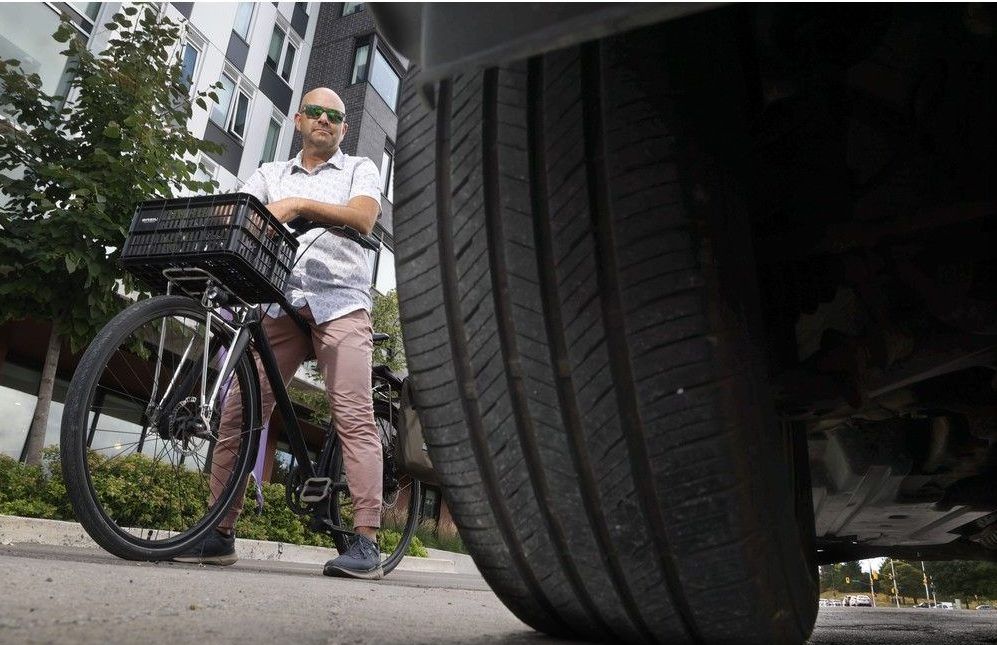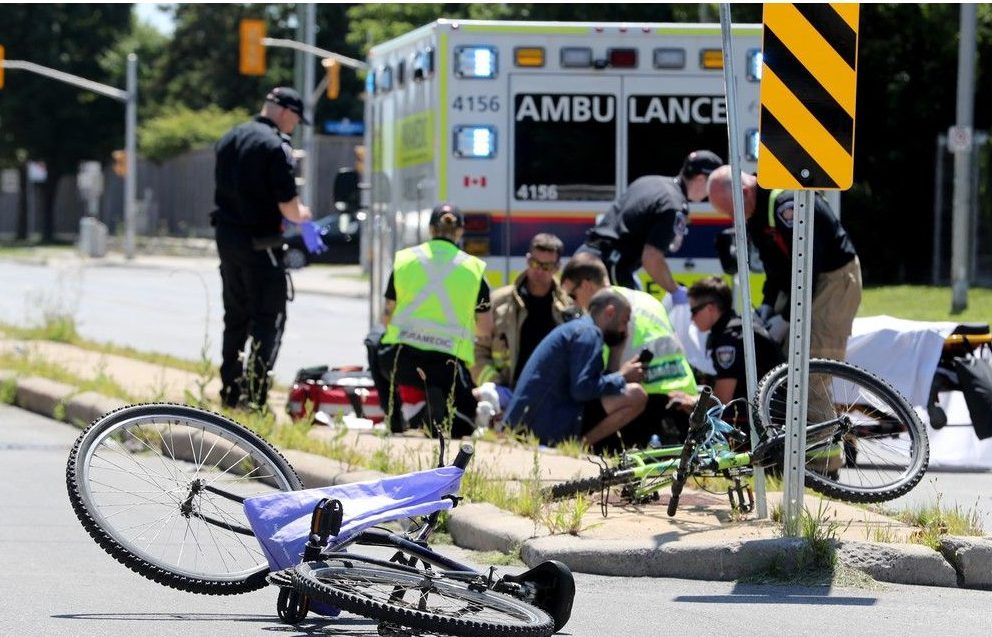Dave Robertson
counts himself as one of the “fortunate” ones.
While riding his bike in downtown Ottawa to a morning dentist appointment a few years ago, a car drove up right beside him and, Robertson said, tried to run him off the road.
Robertson escaped that incident with minor cuts and scrapes, the car driver was later charged and Robertson returned to biking. He is also a volunteer with advocacy group Bike Ottawa and is the co-owner of Let’s Go Cargo! bike rentals.
“I’m very fortunate because I stayed on my bike. I have no idea how I did,” he said. “If I hadn’t, it could have been a very, very, very different story.”

Other Ottawa cyclists haven’t been as lucky.
On April 21,
a cyclist was taken to the hospital with serious injuries
following a collision with a vehicle. On May 25, another cyclist struck by a vehicle
died in hospital from his injuries
. As of Aug. 12,
a Stittsville cyclist was still unconscious
following a
July 22 collision
with a vehicle. Four days after that, on July 26,
a cyclist in her 70s died when she was struck by a vehicle
on Mitch Owens Road.
There have also been instances of non-life-threatening collisions, including when
a nine-year-old boy was struck while riding his bike in Barrhaven
.
The Ottawa Police Service (OPS) did not respond in time for publication to questions about exactly how many cyclist-vehicle collisions had occurred in the city this summer and whether there had been more incidents or fatalities than in previous years.
But it’s clear that there have been numerous recently reported instances, and the recent attention paid to cyclist collisions has prompted advocates, cyclists and experts to
call for safer streets
.
Ottawa roads’ impact on cyclists’ safety
Ottawa’s road designs are similar to the rest of Canada’s, prioritizing car traffic and movement, says Matt Pinder, a senior consultant with Mobycon, a consulting group for sustainable mobility solutions.
“That’s why we have a lot of faster, wider roads, especially the suburban arteries around the city that really encourage speeding,” Pinder said. “Speed and safety don’t tend to mix very well.”
For some cyclists, the greatest threats on Ottawa’s roads are the drivers themselves.
James Murchison said he noticed a change in how drivers treated him when he shifted from riding a motorcycle to riding a bike three years ago. He now documents his
cycling run-ins with construction pylons
and dangerous driving, regularly uploading photos and videos to BlueSky and X.
“When I’m going up to speed or faster than the speed limit, I still get passed really aggressively by drivers,” he said. “In a car or on a motorcycle, that never happens.”
He added that road closures and detours in Ottawa also made it difficult for cyclists to get around safely.
“I’m comfortable biking on the road, in traffic and on some of the more dangerous roads, but I obviously understand how some people won’t do that,” Murchison said. “It’s definitely dangerous to go to many places.”
Types of cyclist-vehicle collisions and their long-term impacts
Dave Shellnutt, managing partner of The Biking Lawyer LLP, representing injured cyclists across Ontario, says most cyclist-vehicle collisions involve drivers making “dangerous decisions behind the wheel.”
Two of The Biking Lawyer’s recent Ottawa-area cases involved drivers hitting cyclists while making turns without coming to a complete stop, he said.

“People behind the wheel are really not taking into account that there are vulnerable road users out there,” Shellnutt said. “We get calls from Ottawa clients pretty regularly where they escape, miraculously, without major injury.”
Some collisions, however, can leave cyclists with lifelong impacts, both physical and otherwise.
Tim Threinen says that in 2023 he was riding his bike when he was passed by a bus and squished between the vehicle and the curb. He says his bike locked up, he was dragged for about 20 feet and he hit his head on a concrete sidewalk.
His bike was damaged beyond repair, he still experiences concussion symptoms, and he says he’s lost about $100,000 because of his inability to return to full-time work. Shellnutt is representing Threinen in an ongoing legal action for health-care costs, lost wages and personal-injury damages.
“It’s completely limiting me,” Threinen said of the accident. “To the kind of person I was before, I’m probably at 10 per cent capacity.”
While Robertson managed to escape his incident without long-term detriments to his health, he has since adjusted his cycling habits.
“I won’t follow the city’s rules anymore,” he said. “I won’t ride in a single file on the street because there’s no way you can put bikes and cars together. I will just go on the sidewalk.”
When it comes to “high-stress” construction zones, Robertson adds that he finds “ways to get out of those situations,” like riding in the construction area if necessary, “just to get away from the cars.”
“My behaviour has changed a lot.”
Insurance complications with cyclist-vehicle collisions
Complications from the exchange of insurance information after a collision involving a cyclist is an Ottawa-specific issue, Shellnutt says.
Ontario’s Highway Traffic Act requires that a person involved in a collision must provide their insurance information to anyone who has sustained loss or injury, police officers or witnesses. Shellnutt says this exchange needs to happen for the cyclist to access no-fault accident benefits, such as funds for rehabilitation or physiotherapy.
“In every other jurisdiction, police provide this (insurance) information to cyclists,” he said. “In Ottawa, they say you have to make a Freedom of Information (FOI) request.”
An FOI request is a formal application to access information and records held by a government institution, which they must respond to within 30 days.
“Those delays negatively impact and even harm cyclists,” Shellnutt said. “It’s insane.”
In an emailed statement, an OPS spokesperson said officers would collect and document the involved parties’ insurance information at the scene, which could then be exchanged or made available in a police report.
“We ask individuals involved in a collision to submit FOI requests for privacy reasons,” OPS wrote. “Their identities or the identities of their lawyers/representatives need to be confirmed before information from police reports, which include personal information, are released.
“Sometimes delays in receiving results from an FOI request can be the result of factors like waiting for initial reports to be finalized.”
What cyclists can do to keep themselves safe
Tracking bike rides with GPS systems like Strava can help prove a cyclist’s case that they weren’t at fault in a collision, Shellnutt says.
“What I tell myself, when I’m riding my bike, is to expect the unexpected,” he said. “Assume that the driver to your left doesn’t have their indicator on, is not slowing down and is going to cut in front of you.”
At the beginning of August, Bike Ottawa also launched the Cycling Guide app, which highlights the safest cycling routes in the city to “make people feel comfortable,” according to Robertson.
Before Threinen’s accident, he always wore high-visibility clothing and had lights on his bike. But the easiest thing a cyclist can do is to wear a helmet, he added, which likely saved him from further injury.
“If I didn’t have a helmet, I’d probably be a vegetable by now.”
Bike Ottawa board member Guillaume Gaillard says the question shouldn’t be about what cyclists can do to protect themselves.
“That question puts the onus on the most vulnerable (road) users, which doesn’t seem really fair,” he said. “One of the things that cyclists can do is push the city and advocate for some proper changes.”

Calls for ‘Vision Zero’
Vision Zero
is a global movement aimed at eliminating traffic fatalities.
Recently, Somerset ward Coun. Ariel Troster
renewed her Vision Zero call
to eliminate right-hand turns for vehicles on red lights in Ottawa’s downtown core after witnessing the aftermath of a
pedestrian collision
near City Hall.
On Aug. 7, the advocacy group Ecology Ottawa put out a petition to “protect vulnerable road users in Ottawa,” including pedestrians and cyclists. The petition called for eliminating right and left turns on red lights at downtown intersections, and the outright prohibition of vehicle turns on red lights at all protected intersections.
The petition has about 500 signatures as of Aug. 13, Ecology Ottawa executive director William van Geest said.
“One story after another of people being hit by drivers, and either being severely injured or killed … that’s a huge problem,” he said. “And how many (accidents) do we not hear about, or how many people are just staying home or avoiding certain places because of the threat to them?
“We really need to be much more serious about keeping people safe in our city.”
Separating cyclists and the city’s approach
“The City of Ottawa remains deeply committed to the safety and well-being of all road users and we continue to prioritize the safe and efficient operations of our roads and intersections,” Stu Edison, the manager of traffic operations, wrote in an emailed statement.
Ottawa’s Road Safety Action Plan is “an integrated, comprehensive, and proactive strategy for making our roads safer for all users and for continuing to advance toward zero fatal and major injury collisions.”
For 2025 implementation, the plan included cycling enhancements at certain intersections and funds to enhance cycling safety through signage and pavement markings.
Pinder, with Mobycon, said Ottawa had done “quite a few things well” relative to other Canadian cities, like separating vehicle traffic from cyclists with physical barriers such as plastic stick dividers instead of relying solely on painted lanes.
However, he noted, painted dividers remain the sole barriers between cyclists and vehicles in many areas of the city.
“There are thousands of kilometres of streets in this city, and it’s going to take a long time to cover the whole network, but it’s constantly improving.”
Pinder added that “a more uniform approach to how we set speed limits” and reducing speeds on busy roadways like Hunt Club Road could make for a more cyclist-friendly environment.
“The faster that a vehicle is going when they strike that cyclist, the higher the likelihood of that cyclist being killed,” Pinder said. “It’s really hard to say that speed wasn’t a factor.”

For cyclists like Robertson, though, the conversation about cyclist safety should begin with the city and municipal leaders.
“A lot of the time it’s conversations with cyclists like, ‘How do you stay safe?’ but that’s not the issue,” he said. “They’re not out there getting hurt themselves; they’re getting hit by drivers.
“We need our city to do better.”
Our website is your destination for up-to-the-minute news, so make sure to bookmark our homepage and sign up for our newsletters so we can keep you informed.
Related
- Maintenance cost for Victims of Communism memorial jumps to $1 million
- New Heart Institute unit helping patients stay out of emergency departments



